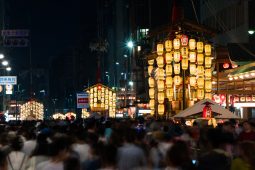Japanese culture holds a deep respect for seasonality. From the reflection of seasons in traditional Haiku, to the waves of seasonal foodstuffs celebrated in markets across the country, marking the changes through the year is taken very seriously here.
Every time of year has its own collection of traditions, festivals, and highlights, and this being summer, I thought I’d introduce a few insights into how the season of heat is marked in Japan.
Summer is the season of…
Fireworks. All across Japan, municipalities host fireworks show throughout the season. They usually take place near beaches or rivers to help with fire safety, and are wonderful celebrations. Before the big show, the area will fill with yatai (屋台, stalls) selling all manner of Japanese street foods like yakisoba (stir fried noodles with pork and vegetables), yakitori (grilled skewers of chicken, vegetables, and meat), and more. Young people dress up in traditional summer clothing like jinbei 甚平 (thin linen or cotton tops and shorts) for men, or yukata 浴衣 (colorful, light summer kimono-like robes) for women.
Children compete at games like goldfish scooping 金魚すくい with paper paddles, and eat candied apples in the summer heat.
The major fireworks shows, like in Sumidagawa in Tokyo or Miyajima in Hiroshima, attract enormous numbers of people and tie up public transport, so if I were you I’d look for smaller local events. You can still enjoy the festival atmosphere without the horrific crowds.
Ghosts. July and August is the time of Obon (お盆or the Bon festival). This ancient festival is like a Buddhist version of Mexico’s Dios de los Muertos, when the spirits of deceased ancestors return to the world of the living. People put out relatives’ favorite snacks and drinks, and communities all over Japan welcome family members’ spirits home with festivals centered around the Bon dance, traditional music, and all those fun festival staple foods.
Obon takes place at different times in different regions, but you’re sure to run into a local festival if you poke around in mid to late August (July in parts of Kanto) and follow the distinctive taiko rhythm.
This might also have some connection to the tradition of Japan’s scary season being summer, rather than autumn like in the US and western Europe. TV channels run scary story shows and horror anthologies, horror movies fill cinemas, and people tell ghost stories at night to find a little relief form the heat through the chill of fear.
Festivals. In addition to the general fireworks and Obon festivals mentioned above, there are all kinds of special regional festivals all over Japan all summer long.
Some of the highlights include:
Gion Yamakasa, Hakata, Fukuoka, early July. This is one of Japan’s great festivals, where teams of young men carry massive お神輿 Mikoshi portable shrine floats through the streets of Hakata at a dead run. It’s a frantic, sweaty, and exhilarating sight lubricated with lots of sake and cold water.
Nebuta/Neputa Matsuri, Various places in Aomori, Early August. Neputa means “parade float,” but the floats of Aomori’s Nep(b)uta festivals are incredible works of art that take months to make. The Nebuta festival in Aomori city is the most famous, with Hirosaki’s Neputa festival slightly less so, but it can be hard to get a hotel room around either. There are smaller Nebuta festivals in thirty other towns and villages across the prefecture around the same time.
Awa Odori 阿波おどり, Tokushima City, Tokushima, mid-August. This dance festival in mid-August fills the streets of Tokushima city with men and women in traditional dress dancing in formation for kilometers. People form teams in the companies, schools, neighborhoods and just among friends to take part in a very unique take on the Bon dance. Also known as the Fool’s Dance (from the old saying “Fools dance and fools watch, so if we’re all fools, why not dance?”). It is a huge tourist draw, and hotels are often booked up months in advance. It takes planning to visit, but is an incredible experience.
Soma Nomaoi, Soma district, Fukushima Prefecture, end of July. This is a truly unique festival, involving neither floats nor Mikoshi: it’s a horse-mounted battle reenactment! Men on horseback wearing traditional armor race around a field trying to catch firework-launched flags from the air in a frenzied battle. For three days, various events hosted by three different shrines in the Soma district recreate the traditional samurai spirit with various levels of pageantry.
Specific dates for all these vary year by year, so check the internet for the exact dates.
And finally, Japanese summer is the season of…
Heat. Summer in Japan is hot, and getting hotter. Record heatwaves hit Japan in 2018, with temperatures exceeding 40 degrees Celsius in some places. Even without heatwaves, temperatures in the mid-30s are common , and the humidity can be terrible as well. Even places in Hokkaido can exceed 30 degrees. Whatever you do in summer, make sure you drink plenty of fluids, keep out of the direct sun as much as you can, and always stay safe while you have your fun!








